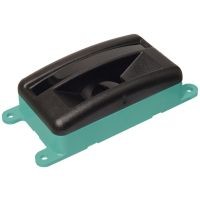R2100—World’s First Multiray LED Scanner (2-D LiDAR Sensor)
A Distance Ahead—Photoelectrics by Pepperl+Fuchs

The multiray LED scanner R2100
The multiray LED scanner R2100 (2-D LiDAR sensor) from Pepperl+Fuchs is a photoelectric distance measurement sensor combining three breakthrough technologies into one revolutionary device.
2-D Detection with Multiray Scan–No Moving Parts
The R2100 is able to evaluate objects in two dimensions with multiray scan. Equipped with these breakthrough technologies, the multiray LED scanner (also known as 2-D LiDAR sensor) becomes an economic solution with exceptional performance, flexibility, and durability. The new R2100 evaluates a 2-D area over 88 degrees by employing multiple emitter elements arranged side-by-side.
Robust 2-D Measurement
The future of LED technology is now. For the first time, distance measurement sensors are utilizing eye-safe, Ultra-IR LED emitters. These infrared LEDs provide an alternative to costly, temperature sensitive, and potentially harmful laser emitters—without sacrificing power. Additional cooling equipment for use in extended temperature ranges is no longer necessary. The R2100 is the first distance measurement sensor equipped with Ultra-IR LED technology and delivers an impressive 8 meter operating range to object without the need for a reflector. Ultra-IR LEDs also produce a larger light spot compared to laser emitters. The multiray LED scanner R2100 (2-D LiDAR sensor) has a distinct advantage over laser scanners when detecting objects with irregular surfaces or textures.
Pulse Ranging Technology inside—Maximum Precision and Reliability
Pulse ranging technology (PRT) is the most effective time-of-flight measurement technology on the market today. It provides maximum precision and reliability over large distances, even in harsh ambient conditions. Sensors equipped with PRT emit a very short, high-intensity light pulse and calculate object distance based on the time-of-flight of the reflected light.
Breakthrough Technologies for Ground-Breaking Applications
The R2100 multiray LED scanner (2-D LiDAR sensor) is a revolutionary, 2-D distance measurement sensor, combining true time-of-flight PRT with a host of innovative features—the perfect solution for versatile tasks including object positioning and collision avoidance on overhead monorails, robots and gantries.
Highlights
- PRT provides reliable and precise distance measurement information
- Ultra-IR LEDs guarantee powerful performance and long life
- No moving parts for added durability in difficult application environments
- 2-D measurement with multiray scan
- Multiple, wide-beam emitters ensure reliable object detection regardless of surface texture
- Low current consumption reduces energy-related design and operating costs
- Fast response time for rapid processes










 +1 330 425-3555
+1 330 425-3555